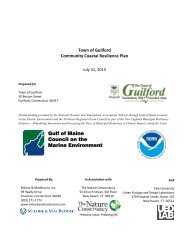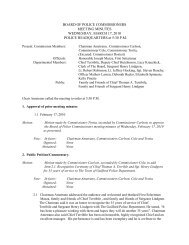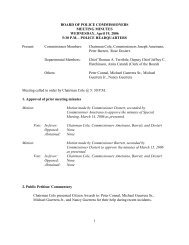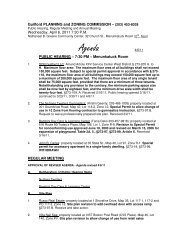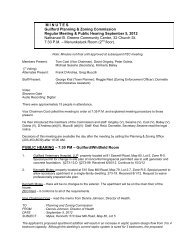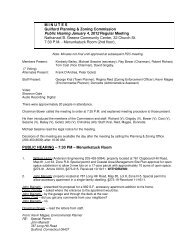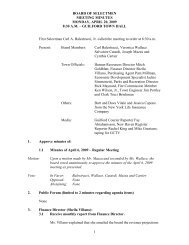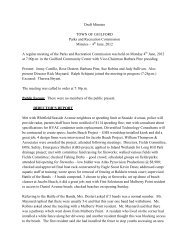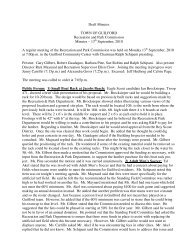Natural Resource Inventory and Assessment - Town of Guilford
Natural Resource Inventory and Assessment - Town of Guilford
Natural Resource Inventory and Assessment - Town of Guilford
Create successful ePaper yourself
Turn your PDF publications into a flip-book with our unique Google optimized e-Paper software.
Section I NATURAL RESOURCE-BASED RECREATION<br />
I.1 Introduction<br />
See separate Map Atlas for map references<br />
This section is intended to <strong>of</strong>fer a fresh perspective on recreational issues as they relate to natural<br />
resources. A physical inventory <strong>of</strong> natural resources that are currently used for recreation is then presented,<br />
along with brief descriptions <strong>and</strong> comments. <strong>Guilford</strong> now possesses an excellent array <strong>of</strong> outdoor public<br />
recreational areas. However, l<strong>and</strong> managers are faced with the problem <strong>of</strong> balancing recreational use with<br />
protecting the integrity <strong>of</strong> the resource upon which it is based. L<strong>and</strong> or water areas designated for recreation<br />
need varying degrees <strong>of</strong> control <strong>and</strong> must be monitored for possible abuse <strong>and</strong> overuse. This is a critical aspect<br />
<strong>of</strong> any stewardship program for natural resources. <strong>Guilford</strong> has aggressively worked toward setting aside open<br />
space, but systematically addressing l<strong>and</strong> management issues subsequent to purchase is a project still in its<br />
infancy. It is hoped that the following will stimulate more discussion among <strong>Town</strong> <strong>of</strong>ficials in regards to the<br />
management <strong>of</strong> <strong>Guilford</strong>’s recreation areas. Questions are raised indicating the need for further study <strong>and</strong><br />
dedicated policy-making in the area <strong>of</strong> l<strong>and</strong> stewardship.<br />
I.2 Characteristics <strong>of</strong> <strong>Natural</strong> <strong>Resource</strong>-based Recreation<br />
Terms such as “passive” or “informal” traditionally have been used to loosely describe the kinds <strong>of</strong><br />
recreation such as playing fields <strong>and</strong> buildings that do not involve intensive development <strong>of</strong> the l<strong>and</strong>scape.<br />
However, <strong>of</strong>ficials are hard-pressed to define exactly what is meant by these terms. To clarify the <strong>Town</strong>’s<br />
discussions <strong>of</strong> recreational issues, the NRIA uses the term natural resource based (NRB) recreation, defined<br />
as outdoor leisure activities compatible with natural resource protection, <strong>and</strong> typically dependent on an<br />
unstructured setting. Keeping in mind that an interpretation <strong>of</strong> any particular activity <strong>of</strong>ten depends on the<br />
viewpoint <strong>of</strong> the person who is doing it, here is a list <strong>of</strong> some general criteria for NRB recreational activities:<br />
• contact with undeveloped or minimally disturbed l<strong>and</strong>scapes is required<br />
• quiet <strong>and</strong> solitude are valued<br />
• presence <strong>of</strong> wildlife is desirable or essential<br />
• non-competitive; goals are individual<br />
• may or may not be construed as a “sport”<br />
• minimal structures <strong>and</strong> l<strong>and</strong>scape changes are used (e.g., trails, footbridges, kiosks, clearings for<br />
vistas or habitat enhancement)<br />
• minimal, <strong>of</strong>ten unimproved, parking facilities blend into surroundings as much as possible<br />
• transport is by foot <strong>and</strong> possibly, if compatible, by bicycle, wheelchair, or horseback<br />
• impact on the resources is carefully balanced with achieving recreational goals.<br />
I.3 Managing Agencies <strong>and</strong> Organizations<br />
It is the task <strong>of</strong> the agencies or people acting on behalf <strong>of</strong> the owner to determine which recreation<br />
activities are appropriate for a given l<strong>and</strong> or water area, to regulate them, <strong>and</strong> to maintain basic<br />
accommodations for access. <strong>Natural</strong> resource considerations should be primary in this determination.<br />
Even when applying the criteria listed above, it can be difficult to clearly delineate which specific recreation<br />
activities are actually compatible with good resource management. Much depends upon the site in question<br />
<strong>and</strong> even the time <strong>of</strong> year, so it is the where <strong>and</strong> when as well as the what that must be considered. (See<br />
Sections B. Coast, C. Freshwater <strong>and</strong> D. Upl<strong>and</strong>s, <strong>and</strong> Section I.6 for further discussion <strong>of</strong> recreational activities’<br />
impact on natural resources.)<br />
Public recreation takes place primarily on l<strong>and</strong> owned by the <strong>Town</strong>, the State, South Central<br />
Connecticut Regional Water Authority (SCCRWA), or <strong>Guilford</strong> L<strong>and</strong> Conservation Trust (GLCT). For the<br />
town, the primary governing agencies are the Parks <strong>and</strong> Recreation (PRC) <strong>and</strong> Conservation (CC)<br />
Commissions. Athletic fields are governed by the Board <strong>of</strong> Education <strong>and</strong> cared for by the Parks <strong>and</strong><br />
<strong>Natural</strong> <strong>Resource</strong> <strong>Inventory</strong> <strong>and</strong> <strong>Assessment</strong> <strong>Town</strong> <strong>of</strong> <strong>Guilford</strong>, CT I1<br />
<strong>Natural</strong> <strong>Resource</strong>-Based Recreation



